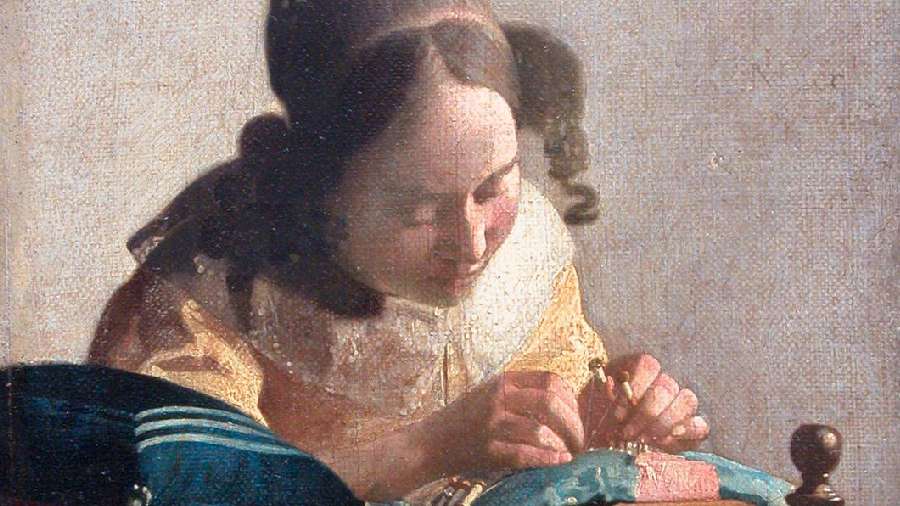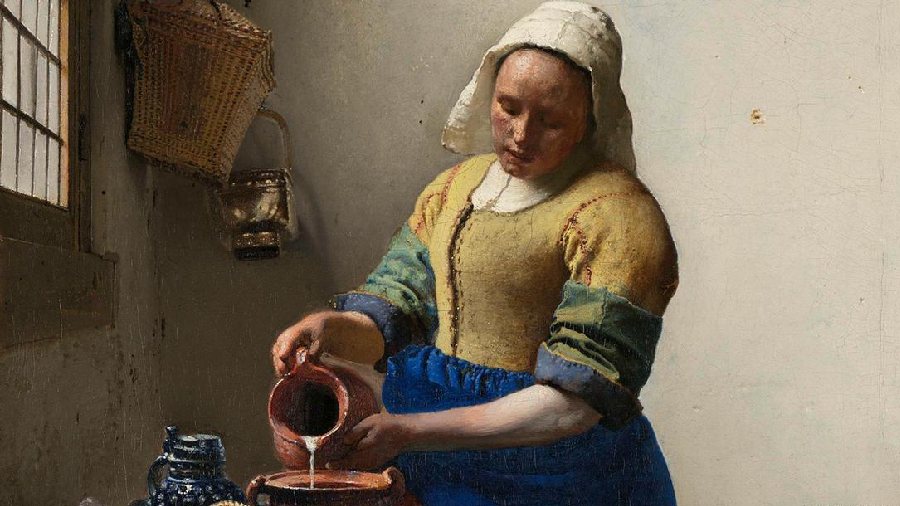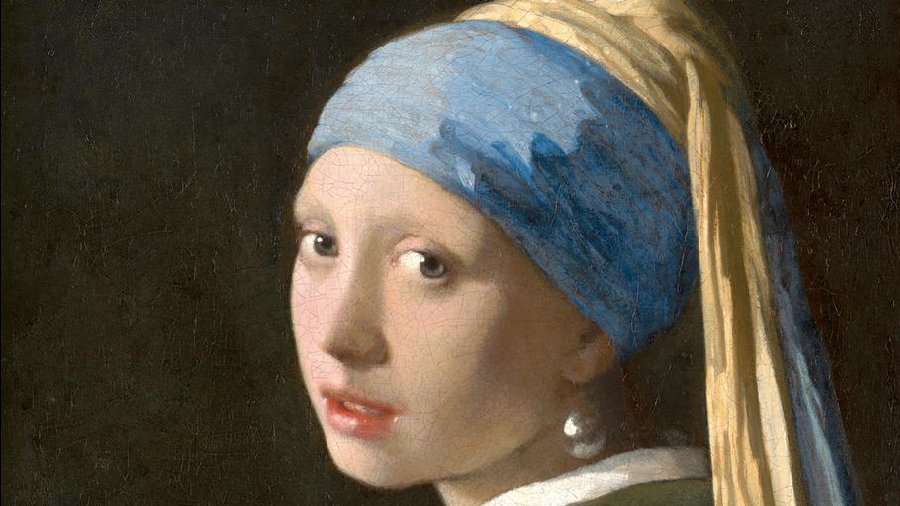The facades of two red brick houses stand out against a cloudy sky. In a narrow passageway between them a housemaid bends over a container, framed by a doorway. She's been scrubbing; the water is still shimmering in the gully. Two children are playing on the curb, while a woman sits in the open door of the house and sews. This scene of 17th-century middle-class life in the Dutch city of Delft is but a moment, one that is over in the blink of an eye — and yet it is one that lasts forever, immortalized by the Dutch painter Jan Vermeer (1632-1675), whose full name was Johannes Vermeer.
Vermeer is considered the greatest painter of his era, alongside Rembrandt (1606-1669). He masterfully captured different materials and surfaces on his canvas: the rough brick, lead-glazed windows, weathered wooden shutters, whitewashed sections of walls. Everything looks real, almost photographic: the contrast of light and dark, the perspectives, the quiet that quivers with energy.

A scene from daily life in the 17th century: Vermeer's 'The Little Street' Deutsche Welle
28 Vermeer masterpieces from around the world
"The Little Street" is a masterpiece, as are all of Vermeer's other paintings that have survived, though there are not many of them.
When he died in December 1675 at the age of 43, his oeuvre comprised 37 paintings; 28 are now on show at the Rijksmuseum in Amsterdam, eight more than 26 years ago in the Mauritshuis museum in The Hague. The works of art were borrowed from major international museums and from private collections in Europe and the US. Private sponsors reached deep into their wallets. It's the largest solo Vermeer show to date.
What attracts Vermeer fans is difficult to describe: Vermeer's handling of the brush and paint, his technical skill, the virtuoso play with lighting effects, the composition, the fidelity of perspective. "Vermeer was a master of light," said Gregor Weber, co-curator of the exhibition in Amsterdam. No artist has ever painted light like Vermeer, in a way that is realistic and yet full of enigmatic calm, he noted..
From biblical stories to everyday images
Diana, the goddess of the hunt, is surrounded by companions. One of them washing Diana's feet. It's a scene from ancient mythology. The story of the chaste goddess was a popular subject of Dutch painting.
The young Vermeer also idealized such figures. Italian influences are also evident in his work, even though the Delft native never left his hometown.
At 21, Vermeer enrolled in the Delft Guild of Saint Luke as a master painter.
He initially took up historical themes: scenes from the Bible, from ancient history, legends of saints.
His brushstrokes are bold, creating large areas of color whose strong contrasts of light and dark are reminiscent of Italian role models, Caravaggio (1571-1610), for example.
Scholars still puzzle over why Vermeer changed his subject of interest from 1656 onward.
Was it a breakaway? No, Vermeer's switch to genre paintings was a leap in development. He began incorporating everyday scenes into his paintings: a maid pouring milk into a jug; a young girl writing letters; a daughter from a good family at a music lesson on the virginal, a small harpsichord.
They are all interior scenes, with the exception of those two famous city views, "The Little Street" and the "View of Delft."

'The Lacemaker' was painted by Vermeer in 1670-71 Deutsche Welle
They are imagined interiors and yet they provide intimate glimpses of everyday life in the 17th century. Time seems to stand still. "Vermeer's paintings are not narratives in the sense that there's a lot going on, a lot of running around, like horses galloping or something falling to the ground or people fighting or something like that," says Vermeer expert Weber."His paintings are always very quiet, very introverted," adds Weber. Vermeer's works hold a secret. It's that very stillness that so fascinates today's audiences.
Jan Vermeer, master of light
Was it Pieter de Hooch (1629-1684) who influenced Vermeer?
Scholars are still searching for answers. Vermeer refined his painting technique over the years.
With small dabs of color, he created the illusion of light dancing on the surface. The elements of the painting become vivid, almost three-dimensional. The pearl of the girl with the pearl earring, for example, is simply depicted through reflections of light — no more, but also no less!
His pointillism — a technique employing small, distinct dots of color in a pattern to create an image — made Vermeer famous.
In 1664 and 1665, he painted interiors that stylistically belong together: It is always the young woman, sometimes with scales, sometimes with a water jug at the window, with a pearl necklace or even as a "letter writer in yellow." They are idealized scenes from daily life, each one well composed in and of itself.
The master from Delft did not use the camera obscura, the pinhole camera, to find his perspective, as was previously assumed. The current theory is that he used the so-called pin-and-string method, in which he stuck a pin in his canvas and attached threads to it to draw his perspective lines. Other painters also used this technique. Restorers discovered by X-ray a barely detectable hole in many of the Vermeer paintings they examined.

Close examination of "The Milkmaid": researchers sometimes unearth motifs that have been covered up Deutsche Welle
But that's not all. They also unearthed what the artist had originally intended to portray: a lute, for example, in the painting "Woman with a Pearl Necklace," or a naked youth in the painting "Girl Reading a Letter at an Open Window," which Vermeer or an artist after him painted over because this would have been understood as an erotic allusion.
A world great
Vermeer's late paintings are characterized by a strong incidence of light, yet the painting technique appears simplified.
The Delft master may have painted his last picture in 1675, "Lady Seated at a Virginal."
In Amsterdam's Rijksmuseum, unlike previously in The Hague, the works hang in spacious rooms where heavy curtains provide atmosphere.
All paintings are protected by a glass pane. For good reason: As recently as October, climate activists had attacked the world-famous "Girl with the Pearl Earring" with glue and red liquid, but the work remained undamaged.

'The Milkmaid' by Jan Vermeer, from 1658-59 Deutsche Welle
Jan Vermeer died impoverished in 1675. He left behind a wife and 10 underage children. Soon after his death, the artist was forgotten. It was not until the 19th century that art historians rediscovered his work.
Today, Vermeer is considered one of the world's greatest painters, mainly because of the quality and originality of each painting — all masterpieces.
Just days before the exhibition opens on February 10, over 150,000 tickets have already been sold. The show at the Rijksmuseum, which runs through June 4, 2023, has what it takes to become the art event of the year.











